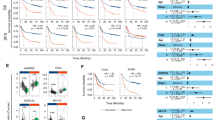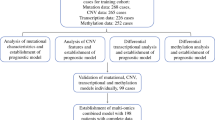ABSTRACT
Background
Gastric cancer (GC) relapse can occur even if curative resection is achieved. Biomarkers predicting recurrence are needed to provide appropriate postoperative surveillance and perioperative therapeutic strategy.
Methods
A global expression profiling was performed using tissues from GC patients with synchronous liver-confined metastasis. Family with sequence similarity 46, member C (FAM46C), was identified as a candidate biomarker. mRNA expression analysis, direct nucleotide sequencing, bisulfite sequencing and copy number assays for FAM46C were performed with eleven GC cell lines. Expression levels of FAM46C in primary GC tissues from 129 patients who underwent curative GC resection were determined and correlated with clinicopathological factors, including postoperative outcome.
Results
Levels of FAM46C mRNA differed among GC cell lines. Point mutations in FAM46C were detected in five GC cell lines accompanied with reduced FAM46C transcription. No hypermethylation was found in the promoter region of FAM46C. Copy number alterations were found in six GC cell lines with differing FAM46C transcription levels. Reduced FAM46C mRNA expression levels were detected in 117 (91 %) GC specimens compared with adjacent noncancerous tissues. Low FAM46C expression levels were significantly associated with larger macroscopic GC tumor sizes. The low FAM46C expression group was likely to have shorter disease-free survival than the high group and low FAM46C level was identified as an independent risk factor for recurrence after curative resection. FAM46C expression levels were low in all cases that were later found to have hepatic recurrence.
Conclusions
Reduced GC expression of FAM46C is a potential biomarker to predict hepatic recurrence after curative gastrectomy.



Similar content being viewed by others
REFERENCES
Siegel RL, Miller KD, Jemal A. Cancer statistics, 2015. CA Cancer J Clin. 2015;65:5–29.
Kanda M, Murotani K, Kobayashi D, et al. Postoperative adjuvant chemotherapy with S-1 alters recurrence patterns and prognostic factors among patients with stage II/III gastric cancer: a propensity score matching analysis. Surgery. 2015;158:1573–80.
Van Cutsem E, Sagaert X, Topal B, Haustermans K, Prenen H. Gastric cancer. Lancet. 2016. doi:10.1016/S0140-6736(16)30354-3.
Lin LL, Huang HC, Juan HF. Discovery of biomarkers for gastric cancer: a proteomics approach. J Proteomics. 2012;75:3081–97.
Kanda M, Shimizu D, Fujii T, et al. Function and diagnostic value of Anosmin-1 in gastric cancer progression. Int J Cancer. 2016;138:721–30.
Yachida S, Jones S, Bozic I, et al. Distant metastasis occurs late during the genetic evolution of pancreatic cancer. Nature. 2010;467:1114–7.
Brosnan JA, Iacobuzio-Donahue CA. A new branch on the tree: next-generation sequencing in the study of cancer evolution. Semin Cell Dev Biol. 2012;23:237–42.
Kim R, Schell MJ, Teer JK, Greenawalt DM, Yang M, Yeatman TJ. Co-evolution of somatic variation in primary and metastatic colorectal cancer may expand biopsy indications in the molecular era. PLoS ONE. 2015;10:e0126670.
Kanda M, Shimizu D, Tanaka H, et al. Metastatic pathway-specific transcriptome analysis identifies MFSD4 as a putative tumor suppressor and biomarker for hepatic metastasis in patients with gastric cancer. Oncotarget. 2016;7:13667–79.
Kanda M, Tanaka C, Kobayashi D, et al. Epigenetic suppression of the immunoregulator MZB1 is associated with the malignant phenotype of gastric cancer. Int J Cancer. 2016;139:2290–8.
Sobin LH, Gospodarowicz MK. TNM classification of malignant tumors. 7th edn. New York: Wiley-Blackwell: 2009
Japanese Gastric Cancer Association. Japanese classification of gastric carcinoma: 3rd English edn. Gastric cancer. 2011;14:101–12.
Tanaka H, Kanda M, Koike M, et al. Adherens junctions associated protein 1 serves as a predictor of recurrence of squamous cell carcinoma of the esophagus. Int J Oncol. 2015;47:1811–8.
Oya H, Kanda M, Sugimoto H, et al. Dihydropyrimidinase-like 3 is a putative hepatocellular carcinoma tumor suppressor. J Gastroenterol. 2015;50:590–600.
Ezaka K, Kanda M, Sugimoto H, et al. Reduced expression of adherens junctions associated protein 1 predicts recurrence of hepatocellular carcinoma after curative hepatectomy. Ann Surg Oncol. 2015;22 Suppl 3:1499–507.
Kanda Y. Investigation of the freely available easy-to-use software ‘EZR’ for medical statistics. Bone Marrow Transplant. 2013;48:452–8.
Boyd KD, Ross FM, Walker BA, et al. Mapping of chromosome 1p deletions in myeloma identifies FAM46C at 1p12 and CDKN2C at 1p32.3 as being genes in regions associated with adverse survival. Clin Cancer Res. 2011;17:7776–84.
Barbieri M, Manzoni M, Fabris S, et al. Compendium of FAM46C gene mutations in plasma cell dyscrasias. Br J Haematol. 2015;174:642–5.
Affer M, Chesi M, Chen WD, et al. Promiscuous MYC locus rearrangements hijack enhancers but mostly super-enhancers to dysregulate MYC expression in multiple myeloma. Leukemia. 2014;28:1725–35.
Chesi M, Bergsagel PL. Advances in the pathogenesis and diagnosis of multiple myeloma. Int J Lab Hematol. 2015;37 Suppl 1:108–14.
Schoggins JW, Wilson SJ, Panis M, et al. A diverse range of gene products are effectors of the type I interferon antiviral response. Nature. 2011;472:481–5.
Pei H, Zhang L, Luo K, et al. MMSET regulates histone H4K20 methylation and 53BP1 accumulation at DNA damage sites. Nature. 2011;470:124–8.
Rajkumar SV, Dimopoulos MA, Palumbo A, et al. International Myeloma Working Group updated criteria for the diagnosis of multiple myeloma. Lancet Oncol. 2014;15:e538–48.
Carvalho CM, Pehlivan D, Ramocki MB, et al. Replicative mechanisms for CNV formation are error prone. Nat Genet. 2013;45:1319–26.
Shen L, Shan YS, Hu HM, et al. Management of gastric cancer in Asia: resource-stratified guidelines. Lancet Oncol. 2013;14:e535–47.
Kanda M, Kobayashi D, Tanaka C, et al. Adverse prognostic impact of perioperative allogeneic transfusion on patients with stage II/III gastric cancer. Gastric Cancer. 2016;19:255–63.
Kanda M, Mizuno A, Fujii T, et al. Tumor infiltrative pattern predicts sites of recurrence after curative gastrectomy for stages 2 and 3 gastric cancer. Ann Surg Oncol. 2016;23:1934–40.
Kodera Y, Fujitani K, Fukushima N, et al. Surgical resection of hepatic metastasis from gastric cancer: a review and new recommendation in the Japanese gastric cancer treatment guidelines. Gastric Cancer. 2014;17:206–12.
Oki E, Tokunaga S, Emi Y, et al. Surgical treatment of liver metastasis of gastric cancer: a retrospective multicenter cohort study (KSCC1302). Gastric Cancer. 2016;19:968–76.
Author information
Authors and Affiliations
Corresponding author
Ethics declarations
DISCLOSURE
None.
Electronic supplementary material
Below is the link to the electronic supplementary material.
10434_2016_5636_MOESM3_ESM.tif
Supplementary material 3 (TIFF 1038 kb) Supplementary Fig. 1 Peritoneal recurrences in the high and low FAM46C expression groups
Rights and permissions
About this article
Cite this article
Tanaka, H., Kanda, M., Shimizu, D. et al. FAM46C Serves as a Predictor of Hepatic Recurrence in Patients with Resectable Gastric Cancer. Ann Surg Oncol 24, 3438–3445 (2017). https://doi.org/10.1245/s10434-016-5636-y
Received:
Published:
Issue Date:
DOI: https://doi.org/10.1245/s10434-016-5636-y




